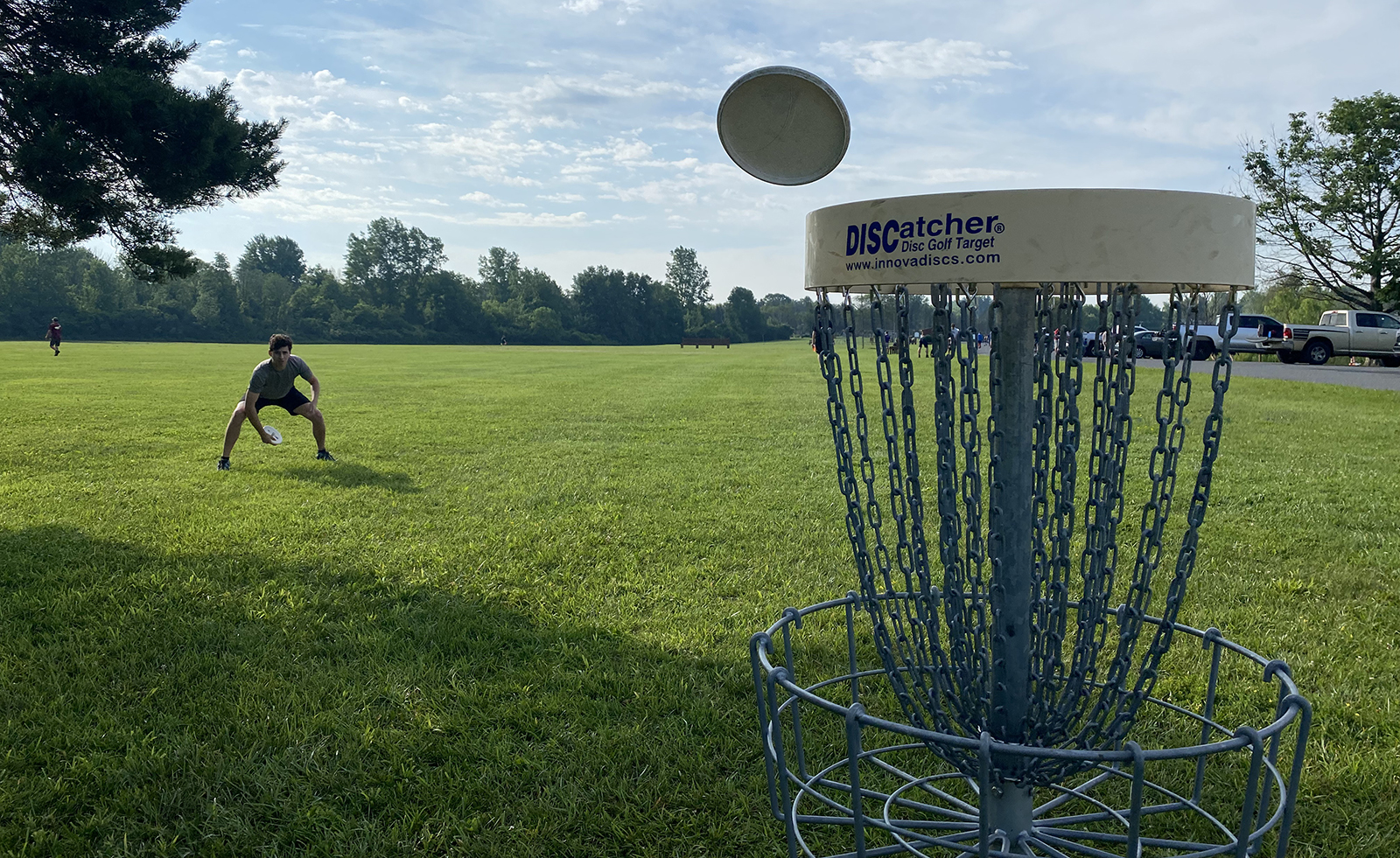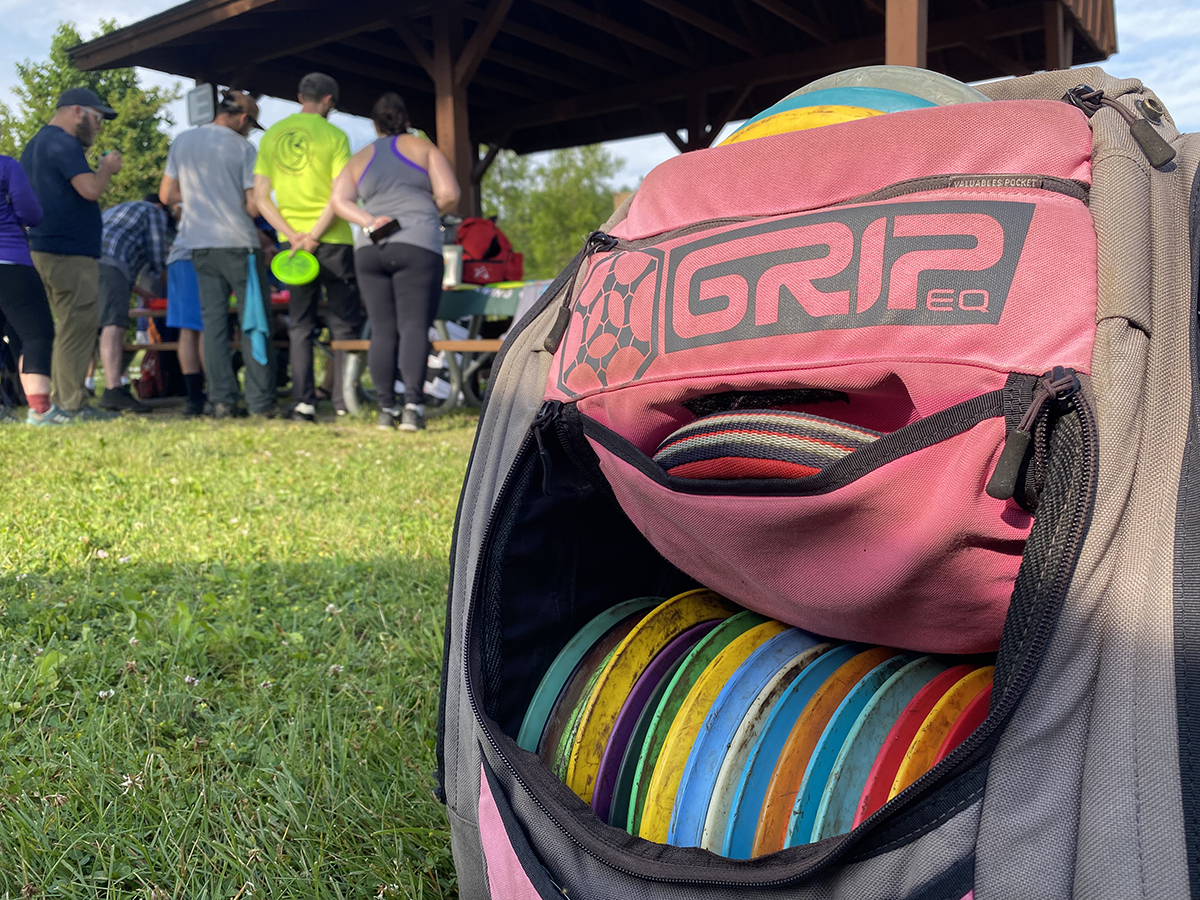

A breakup with his country club forced Greg Earl to consider other ways to act on his passions for golf, the outdoors, and his aversion to doling out a lot of dough to act on those passions. A change of ownership kicked off his departure from Pine Grove Country Club in Camillus, N.Y. But, when it came time to consider alternatives, he and his wife decided to avoid paying the thousands of dollars required to join a new golf course and instead found a cheaper, less time-consuming alternative to their beloved sport — disc golf.
Earl, a Liverpool native, picked up disc golf in 2002 and recently became the president of the Central New York Disc Golf Association (CNYDGA), an organization dedicated to growing the sport of disc golf in central New York and one of more than 80 disc golf associations in the state, including ones in Buffalo, Ithaca, and Albany. To support that growth, CNYDGA offers many opportunities to get involved with disc golf. Those interested can sign up for a $25 membership via the CNYDGA website or join its Wednesday night league this summer, which requires a $10 fee to play.
CNYDGA membership has grown 50% in the past five years — adding more than 150 new members since 2016. That growth mirrors national trends. According to a report by UDisc, an app that tracks disc golf statistics, scorekeeping, and discovery, 50 million rounds of disc golf were played in 2020, which equates to more than 140,000 rounds a day and nearly 100 rounds started every minute. According to the Professional Disc Golf Association, the sport’s member organization and governing body, millions of people play the sport on six continents, and the number of courses tripled from 2008 to 2018. The association hosts the PDGA Professional Disc Golf World Championships in Ogden, Utah, at the end of June. The PDGA hosts tournaments, produces a competition manual, offers resources and guides for course development, and ranks players. In fact, one of the sport’s top players, Paul McBeth, has earned more than $500,000 and in February signed an endorsement deal with Discraft, a disc golf manufacturer, for $10 million over 10 years.
Disc golf, a sport played with “discs, not frisbees,” and a par based off three, incorporates distinct types of discs for different distances, a practice that mirrors the way golf relies on distinct types of clubs for different distances and shots. For example, there are driver discs, putter discs, and several types of fairway discs for different situations. Each disc demands a different type of throw for its intended purpose.
“There is a set of numbers on every disc,” Earl says, which also reflects golf in that different clubs have different numbers to indicate the characteristics of what the club, or in this case the disc, is supposed to do. “They have different rims, different turns, and different glides,” he adds.
And while golf clubs enlist only a single distinguishing number, the discs used in disc golf feature three sets of numbers. The first refers to speed and characterizes the number of rotations the disc is designed to perform when thrown. The second number references glide and indicates how much loft is in the disc — the bigger the dome on a disc, the more loft and glide it possesses. The third number correlates with turn, which indicates the direction the disc will turn when thrown. Just like clubs, players are serious about discs and their nonfrisbee-ness. (Note to newbies: Don’t show up for a game with a circular piece of plastic you received from a job fair or from a team-building workshop. Remove the word “frisbee” from your vocabulary and bring a proper disc or no one will play with you.) Despite the determined anti-frisbee sentiment, it’s worth pointing out that the Father of Disc Golf “Steady” Ed Headrick patented two inventions critical to the sport — the frisbee, which he did in 1966 as an employee at Wham-O, an American toy company, and the targets in 1975.
The targets reinforce disc golf’s connection to golf, including how it is played and the rules of play. There is a par based on the number of throws it takes the golfer to get their disc in the targets, referred to as baskets, which serve as the equivalent of a hole in golf. But unlike holes, baskets sit on a pole and feature a main basket, a lower basket, a frame, and surrounding chains. The PDGA, which began in 1976 and resides, unsurprisingly, outside of Augusta, Ga., governs the dimensions and parameters of the equipment. The sport is scored the same as golf, with the lowest score being the winner.

Balance and stability is as important in disc golf as any other sport. Correct form can make or break the result of the throw. Photo by Jon Harris.
Disc golf’s affordability plays a key role in its popularity and connects to its origins in the hippie culture of Southern California in the 1970s. Discs cost $15 to $20, and most of the courses are free to play. To put it in perspective, while a fairway disc costs $15, a common 7-iron and driver in golf can cost more than $100 and $250, respectively. That affordability also democratizes the sport in a way that speaks to its roots and appeals to many players. “Part of the reason why I love to play is because it is the same game for me as it is for the professionals,” Earl says. “There are no exclusive clubs, if you wanted to play golf at Pebble Beach you would need to pay a fortune and know someone who knows someone. It is not like that here. Ultimately, it comes down to the fact that disc golf is free. Once you own the discs, going out to play disc golf locally is free.”
Earl traces disc golf in central New York back to the 1970s too, when Green Lakes State Park opened the first official disc golf course in the area, becoming the second disc golf course formed in the country. “The first disc golf course in the country was put in place in San Francisco, California, and it was only put in the ground a week and a half before the one at Green Lakes State Park,” says Brad Hartstein, treasurer of the CNYDGA and physical education teacher at nearby Vernon-Verona-Sherrill Middle School.
The affordability also democratizes the sport in a way that speaks to its roots and appeals to many players.
Green Lakes still boasts evidence of that history. “Green Lakes still retains some of the original baskets, which were originally called pole holes because they were simply telephone poles stuck in the ground,” Hartstein says.
Earl and Hartstein anticipate a continued growth in interest and participation. “The potential for the game is huge. I think colleges are starting to pick it up at the club level already,” Earl says.
Harstein sees that interest in his students, too. “The kids really got into it,” he says, referring to the students in his physical education class. “They designed and built their own disc golf baskets and course, and it is all on school property.”
Hartstein is currently working with the New York State Public High School Athletic Association (NYSPHSAA) to try make disc golf a varsity sport — a timely initiative as contact sports experience a decline due to growing concerns regarding concussions. He also played a role in growing the sport throughout the area by helping to build courses at Van Buren Park in Baldwinsville. and Clay Park East in Liverpool, N.Y.
The PDGA also continues to see growing interest. Starting in the 1980s, the association gave registered players a number upon becoming a member. When top 10 finisher in the 2015 disc golf U.S. Amateur Championship Dylan Rees played ultimate frisbee while attending college at the Rochester Institute of Technology in Rochester New York, the number of people playing disc golf paled in comparison with the number who do today. “In the first 30 years, when they were giving out numbers, they only got to 60,000,” said Rees. “In the past eight years or so, they have put in more than 100,000 members, bringing the total to over 170,000 members.” After playing the sport for nearly a decade, Rees began teaching disc golf lessons in Rochester this summer.
Many players in the region credit CNYDGA for growing the sport, creating opportunities to play, and inspiring others to spread their love of the game. Andy Padula, a video director at 325 Productions, a content-based marketing agency in Syracuse, says he enjoys the events CNYDGA organizes and admits he spent the past year immersed in disc golf. In fact, Padula decided to build a course of his own. “When you want to build a disc golf course on any public land, you have to go through the decision-makers in your city or town, which is a process that can take multiple years,” Padula says. “But we were able to get ours done in less than a year.” He built his course at Snow Ridge Ski Resort in Turin, N.Y., a town of 265 people about a 90-minute drive from Syracuse.
“When we pitched the idea of a disc golf course, he was down immediately,” Padula says of the resort’s owner. After getting the green light to build the course, Padula and his friends took a strategic approach to the creation of the course, placing the starting point right outside the resort’s bar and grill. “We wanted that to be our starting point and have it act as the clubhouse to the course,” he says.

Disc golf has been growing in popularity due to the ease it has over ball golf. The discs in disc golf fit and are carried around in a bag much smaller and easier to transport than a golf bag with golf clubs. Photo by Jon Harris.
Padula says he’s played 210 rounds of disc golf in one year. Based on his experience as a player and course builder, he says the flow of the course and its safety serve as the two most important characteristics to consider when building a disc golf course. “We wanted to make sure that we had the most obvious start and end point for our course so that there was no confusion,” Padula says. “We also wanted to make sure we designed the course so that there were no fairways crossing and chances for people to have a disc accidentally thrown at them.”
Padula’s course’s location on a ski mountain sets it apart from other courses, and the mountain provides a drastic elevation change throughout the course, which is long and technical, totaling 7,267 feet and features a variety of challenges with a par 60 on 18 holes.
Building a disc golf course involves much more than sticking a basket into the ground. It requires thoughtful incorporation of trees in the vicinity, hills, and distances and the terrain itself. But the dedication of players and CNYDGA members and the devotion to the game continues to foster the growth of this sport and the success of organizations like the CNYDGA and its leaders, who possess high expectations for the sport and the organization. “We are trying to distinguish ourselves as a very good club to be involved in,” Earl says. “We want to become the best disc golf association in New York state.”

Our pursuit of outdoor joy is remiss without the acknowledgement of the occupation of unceded Indigenous land. We are students and journalists working, writing, and living on the land of the Haudenosaunee Confederacy, comprising the Six Nations made up of the Mohawk, Onondaga, Oneida, Cayuga, Seneca, and Tuscarora nations. However, acknowledgement is not enough. Read More.